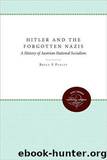Hitler and the Forgotten Nazis by Bruce F. Pauley

Author:Bruce F. Pauley [Pauley, Bruce F.]
Language: eng
Format: epub
Tags: Europe, Presidents & Heads of State, Hitler; Adolf; 1889-1945, General, United States, Austria, Austria & Hungary, Nationalsozialistische Deutsche Arbeiter-Partei in Österreich, Biography & Autobiography, History
ISBN: 9780807841822
Google: mZqnAQAACAAJ
Amazon: 080784182X
Publisher: University of North Carolina Press
Published: 1981-01-01T18:30:00+00:00
CHAPTER X "POSITIVE FASCISM" AND APPEASEMENT
The Austrian government’s nearly total suppression of overt Nazi activity was destined to be short-lived. The Ethiopian War, which began in October 1935, turned Italy from being a defender of Austrian independence into a partner of Nazi Germany. Encouraged by these international developments, the Austrian Nazis regained their confidence and momentum. The government of Kurt von Schuschnigg lacked both the internal strength and the external backing to crush the Nazis. Instead, it felt compelled to appease them. One method of doing this was a program that might be called “positive fascism,” which was designed to imitate what appeared to be the more popular features of fascism in Germany and Italy. The other approach was the “Gentlemen’s Agreement” with Germany concluded in July 1936. Of course, neither policy worked in the long run. But the short-term effects of each policy are not so easy to evaluate.
*
The Nazis’ Neo-Renaissance
If domestic developments during most of 1935 gave the Austrian Nazis small cheer, the same could not be said of the news from abroad. While the employment rate in Austria continued its steady decline in 1934 from 79.8 percent of the 1929 level to 66.8 percent in 1935 and 64.6 percent in 1936, Germany’s masses were rapidly gaining employment. The percentage of employed in 1934 (compared with the 1929 standard) was already 85.5. In 1935 it rose to 90.6 and then to 97.2 in 1936.1 In January 1935 the Austrian Nazis were encouraged by the perfectly free League of Nations’ plebiscite in the Saar district, where over 90 percent of the inhabitants voted to return to German rule. By March 1935 the monthly report of the Security
Directorate admitted that “while one couldn’t speak of the masses being enthusiastic about National Socialism, the public was nevertheless growing lethargic toward the policies and undeniable dynamism of the-Nazis.”2
But what really turned the situation around for the Austrian Nazis was Mussolini’s unquenchable thirst for empire and glory. With the legions of Austria’s one-time protector bogged down in the mountains and deserts of Ethiopia, Austria stood defenseless before the growing might of Nazi Germany. Nor were the Western Democracies willing to fill the military breach. Their timidity was graphically illustrated by their insipid response to Hitler’s reoccupation and remilitarization of the Rhineland in March 1936.
The impact of these developments on Austria’s internal tug of war was both swift and profound. As late as May 1935 Styrian Nazis were attempting to organize a boycott of Italian imports. But the very next month they were encouraged by improving Italo-German relations, and by July they were confidently expecting to benefit from an Ethiopian War that had not yet even begun. In stark contrast, government loyalists were fearful already in September about possible damaging repercussions from the impending war; they became even gloomier following the Rhineland reoccupation the next March.3
The effects of the diplomatic revolution, together with an increase in Nazi spying activities, were soon reflected in the reports of the previously optimistic Austrian Security Directorate. In his
Download
This site does not store any files on its server. We only index and link to content provided by other sites. Please contact the content providers to delete copyright contents if any and email us, we'll remove relevant links or contents immediately.
| France | Germany |
| Great Britain | Greece |
| Italy | Rome |
| Russia | Spain & Portugal |
Fanny Burney by Claire Harman(25789)
Empire of the Sikhs by Patwant Singh(22176)
Out of India by Michael Foss(16313)
Leonardo da Vinci by Walter Isaacson(11912)
Small Great Things by Jodi Picoult(6101)
The Six Wives Of Henry VIII (WOMEN IN HISTORY) by Fraser Antonia(4795)
The Wind in My Hair by Masih Alinejad(4427)
The Lonely City by Olivia Laing(4122)
The Crown by Robert Lacey(4109)
A Higher Loyalty: Truth, Lies, and Leadership by James Comey(4038)
The Iron Duke by The Iron Duke(3642)
Millionaire: The Philanderer, Gambler, and Duelist Who Invented Modern Finance by Janet Gleeson(3573)
Sticky Fingers by Joe Hagan(3456)
Alive: The Story of the Andes Survivors by Piers Paul Read(3317)
Papillon (English) by Henri Charrière(3274)
Joan of Arc by Mary Gordon(3262)
Stalin by Stephen Kotkin(3089)
Aleister Crowley: The Biography by Tobias Churton(3024)
Ants Among Elephants by Sujatha Gidla(2927)
